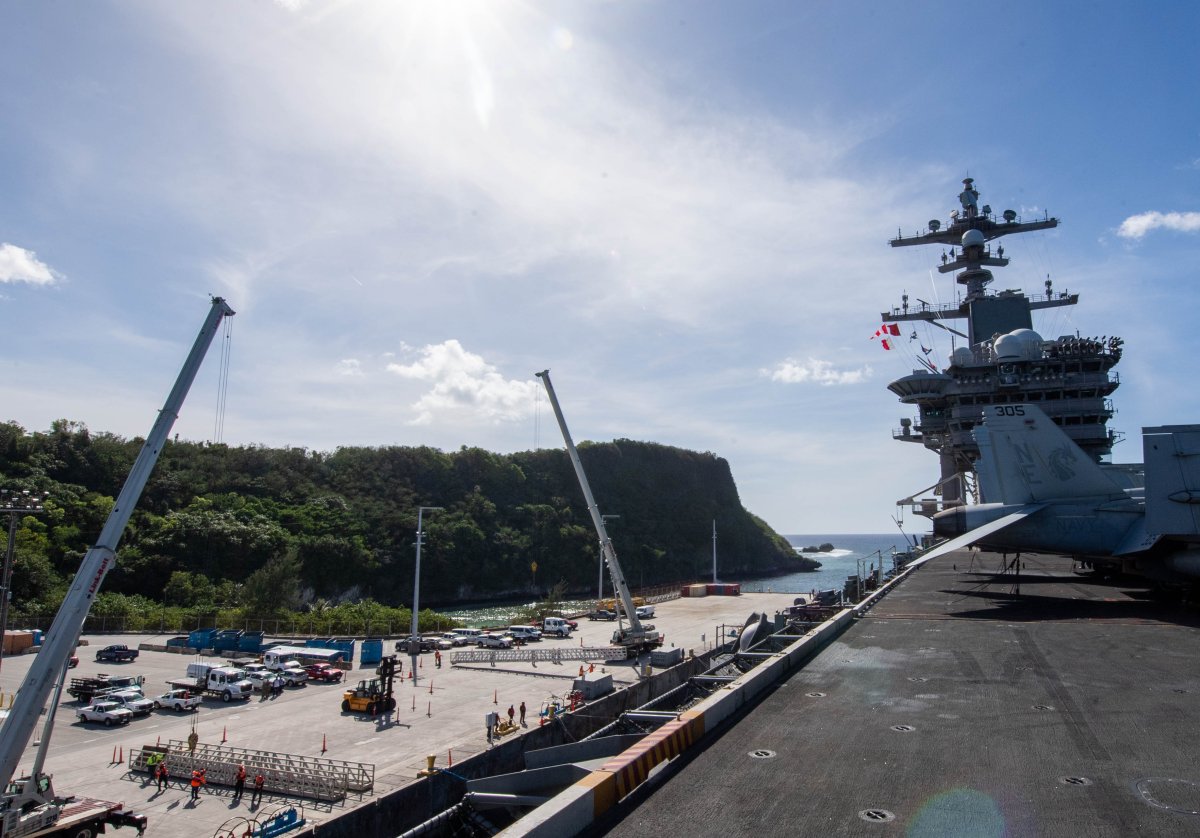-
Gaza families mark Eid al-Adha amid destruction and loss - 23 mins ago
-
A. P. Kid wins 2025 Pennine Ridge Stakes - 26 mins ago
-
Chaos erupts at Paramount Home Depot as protesters confront ICE - 42 mins ago
-
Riley Gaines and Simone Biles Beef Online Amid Trans Athlete Debate - 43 mins ago
-
Rod Stewart, 80, cancels 6 concerts as he battles the flu - 52 mins ago
-
Diamondbacks vs. Reds Highlights | MLB on FOX - about 1 hour ago
-
Israeli forces in Gaza kill 6 Palestinians seeking aid, health officials say - about 1 hour ago
-
FanDuel Promo Code: Claim $500 Belmont Stakes No-Sweat Bet This Weekend - about 1 hour ago
-
Sydney Sweeney and Jessica Simpson make fashion statements at events - 2 hours ago
-
Bet365 Bonus Code WEEK365: Claim $150 Promo For MLB, UFC 316, Any Game - 2 hours ago
Island Chains: Can the US’s Cold War Strategy Still Contain China?
Experts have told Newsweek that the island chain strategy, which was formulated by the United States during the Cold War, remains relevant today in containing Washington’s near-peer competitor, China, as Beijing attempts to push American forces further away from it.
The U.S. strengthened its military deployment in the Asia-Pacific region with “a zero-sum mentality out of its own selfish interests,” heightening regional tensions and jeopardizing regional peace and stability, the Chinese Embassy in Washington, D.C., told Newsweek.
Newsweek has contacted the Pentagon and the U.S. State Department for comment.
Why It Matters
The maritime containment strategy is formed by three island chains in the Pacific Ocean. John Foster Dulles, who was President Dwight D. Eisenhower’s Secretary of State, conceived the strategy during the Korean War, aiming at restricting the Soviet Union and the Communist China’s accesses to the Western Pacific with U.S. allied and friendly territories.
The First Island Chain is formed by three key American allies and partners facing China to the west: Japan, Taiwan, and the Philippines. The second chain stretches from Japan to the island of New Guinea via Guam, which is the westernmost U.S. territory that serves as a military hub. The third one connects Alaska’s Aleutian Islands with New Zealand via Hawaii.
The strategy is facing challenges from China in recent years, which has the largest navy in the world by hull count. The country’s naval fleet, consisting of more than 370 ships and submarines, helps Beijing to expand its military reach and presence within the three island chains, including the unprecedented circumnavigation of Australia that ended last month.
What To Know
Kitsch Liao, associate director of the Atlantic Council’s Global China Hub, said the island chain strategy is more about a balance of power projection, which consists of capability and resolve, as China’s strategic guidance is increasingly aggressive toward the “far seas.”
The U.S. and its allies have to reconceptualize the fight for the island chains as one that “begins far left of bang,” instead taking place in “phase 0” of the conflict, as a significant number of Chinese forces are optimized for peacetime “gray zone” postures, he explained.
“Phase 0” is about influencing the state of affairs in peacetime, including everything that can be done to prevent conflicts from developing in the first place. “Gray zone” refers to the realm of interstate competition that falls between peaceful relations and armed conflict.
For China, the U.S. island chain concept entered its military strategy with Admiral Liu Huaqing, who is viewed as the “father of the modern Chinese navy,” Liao told Newsweek.
In the 1980s, Admiral Liu laid out the ambition of the Chinese People’s Liberation Army Navy (PLAN), which is to control the First Island Chain in the 2000s, the Second Island Chain in the 2020s, and finally become what he described as a “global navy” in the 2040s.
Australian Defense Department
In the Pentagon’s latest report on Chinese military power, it assessed that the Chinese navy continued to grow its ability to conduct missions beyond the First Island Chain in 2023, including three deployments with its aircraft carrier, CNS Shandong, to the Philippine Sea.
The First and Second Island Chains serve as the western and eastern maritime boundaries of the Philippine Sea, respectively. The Luzon Strait and the Miyako Strait, located on the First Island Chain, are key waterways for the Chinese navy to access the Philippine Sea.
The cooperation with Japanese and Philippine forces, as well as the fielding of related U.S. capabilities, such as shore-based anti-ship systems, illustrated the importance of the First Island Chain to the U.S., Australia-based naval analyst Alex Luck told Newsweek.
The U.S. has conducted operations with Japan and the Philippines in the contested South China Sea, which is located within the First Island Chain. It has also deployed a ground-based missile system in the Philippines, capable of hitting a moving target, such as a ship.
Meanwhile, the First Island Chain features controlled by potentially hostile forces during a Taiwan contingency, including the island itself, places restrictions on the deployment of Chinese forces, the analyst added. Beijing has claimed the self-ruled island as its territory.
Japan and the Philippines are located to the north and to the south of Taiwan, respectively. The U.S. has reportedly drawn up an operation plan in the event of a crisis involving China and Taiwan, which includes the deployment of U.S. missiles in both treaty allies.
U.S. national defense objectives are built around assisting in the defense of its treaty allies, including Japan and the Philippines, as well as its territories like Guam, Tom Shugart, who is an adjunct senior fellow at the Center for a New American Security, told Newsweek.

Mass Communication Specialist 3rd Class Nate Jordan/U.S. Navy
What People Are Saying
Liu Pengyu, spokesperson for the Chinese Embassy in Washington, D.C., said: “China always believes that defense and security cooperation between countries should be conducive to regional peace and stability and should not target or harm the interests of any third party.”
Kitsch Liao, associate director of the Atlantic Council’s Global China Hub, said: “As Admiral Liu would characterize it, the PLAN’s aim is to make waters within the First Island chain its ‘internal waters,’ and contesting this would have great implications for surface, aerial, and underwater warfare in the region for the future.”
Alex Luck, an Australia-based naval analyst, said: “For China access to the open Pacific has been one of the driving factors for their force modernization. Chinese blue water forces, especially aircraft carriers and comprehensive expansion in nuclear-powered submarines are particular illustrations of this aspect.”
Tom Shugart, adjunct senior fellow at the Center for a New American Security, said: “China’s strategy has been a little more direct about the island chains, with a strategic timeline that dates back to the 1980s that includes goals of exerting control first within the First Island Chain, and then within the Second.”
What Happens Next
The strategic aim of China in the longer term will be projecting what he called “persistent sea control power” beyond the First Island Chain, which will seek to push U.S. forces further out into the Central Pacific Ocean around the Hawaiian Islands, Luck concluded.
Source link































